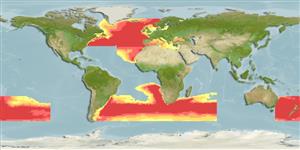Classification / Names
Common names from other countries
Main reference
Size / Weight / Age
Max length : 150 cm SL male/unsexed; (Ref. 4542); common length : 60.0 cm TL male/unsexed; (Ref. 3397)
Environment
Marine; bathypelagic; depth range 40 - 1050 m (Ref. 52180), usually 300 - 700 m (Ref. 52180)
Climate / Range
Deep-water, preferred 18°C (Ref. 107945); 68°N - 55°S, 180°W - 180°E
Distribution
North Atlantic: Nova Scotia and Grand Banks (Canada) to Massachusetts, USA (Ref. 7251). Also known from the Northeast Atlantic and the Mediterranean Sea. Southeast Atlantic and Indian Ocean: South Africa and Australia (including New South Wales). Southwest Pacific: New Zealand. Southern Ocean. Antitropical.
Countries | FAO areas | Ecosystems | Occurrences | Introductions
Short description
IUCN Red List Status (Ref. 115185)
Threat to humans
Harmless
Human uses
Fisheries: of potential interest; gamefish: yes
More information
ReferencesAquacultureAquaculture profileStrainsGeneticsAllele frequenciesHeritabilityDiseasesProcessingMass conversion
Tools
Special reports
Download XML
Internet sources
Estimates of some properties based on models
Phylogenetic diversity index
PD50 = 1.0000 many relatives (e.g. carps) 0.5 - 2.0 few relatives (e.g. lungfishes)
Trophic Level
3.9 ±0.38 se; Based on food items.
Resilience
Very Low, minimum population doubling time more than 14 years (Preliminary K or Fecundity.)
Vulnerability
Very high vulnerability (85 of 100)
Price category
